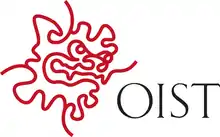Okinawa Institute of Science and Technology
The Okinawa Institute of Science and Technology Graduate University (沖縄科学技術大学院大学, Okinawa Kagaku Gijutsu Daigakuin Daigaku, OIST) is a private,[1][2] interdisciplinary graduate school located in Onna, Okinawa Prefecture, Japan. The school offers a 5-year PhD program in Science. Over half of the faculty and students are recruited from outside Japan, and all education and research is conducted entirely in English.
沖縄科学技術大学院大学 | |
 | |
| Type | Private |
|---|---|
| Established | 1 November 2011 |
| Budget | ¥19.6 billion |
| President | Peter Gruss |
| Provost | Mary Collins |
Academic staff | 75 |
| 211 | |
| Location | , Japan |
| Website | oist.jp |
.jpg.webp)
OIST relies on public subsidies paid by the Japanese government.[3] The government subsidy for OIST comes in two areas: a subsidy for operations and a subsidy for facilities.
Graduate school
The PhD program is taught entirely in English and is individually tailored to each student. Students are encouraged to focus their research on cross-disciplinary areas of studies.[4] Students are recruited through much higher levels of competition than that of the entrance examination for graduate schools of top national universities in Japan.
According to a report completed by an external peer review panel in 2015,[5] OIST is on a par with the 25 universities ranked highest by Times Higher Education, QS or Jiaotong World University Rankings in terms of physical campus infrastructure, management structure and management processes, academic program and recruitment of faculty, graduate program, instrumentation, course to research outcome, technology transfer and welfare, social, and cultural support programs.
Faculty
The faculty at OIST - which consists of assistant, associate, and tenured professors - are recruited from all around the world, including Japan, America, New Zealand, Australia, and Europe [6]
Research
The research community consists of faculty and researchers divided into "units" based on area of study.[7] The university has no departments—OIST researchers conduct multi-disciplinary research[8] in Neuroscience, Physics, Chemistry, Mathematical and Computational Sciences, Molecular, Cellular, and Developmental Biology, Environmental and Ecological Sciences and Marine Science.[9] In 2019 OIST was ranked 1st in Japan and 9th in the world by the Nature Index for the proportion of its research that is published in high-quality science journals.[10]
History
In June 2001 Kōji Omi, former Minister of State for Okinawa and Northern Territories Affairs and former Minister of State for Science and Technology Policy, announced plans to establish a new graduate university in Okinawa. A Board of Governors was appointed in 2004 and the following year, the Diet recognized OIST as an "Independent Administrative Institution".[11] The first class of students were welcomed in September 2012 after receiving approval.[12]
References
- 崇志, 三ツ村 (17 October 2019). "ランキング東大超え。世界から一流研究者が殺到する沖縄科学技術大学院大学が急成長を遂げた秘密". www.businessinsider.jp (in Japanese). Retrieved 18 October 2019.
- "鳥瞰虫瞰 (18)―沖縄科学技術大学院大学訪問記―OISTの光と影 | コラム | 高等教育研究センター | 兵庫大学 兵庫大学短期大学部". www.hyogo-dai.ac.jp. Retrieved 18 October 2019.
- Cyranoski, D (29 June 2011). "Made in Japan". Nature. Nature Publishing Group. 474 (7353): 541–542. doi:10.1038/474541b. PMID 21720321.
- "Degree structure". oist.jp.
- "Report of the External Peer Review Panel 2015" (PDF).
- "OIST Research Units". Retrieved 15 March 2020.
- "Research Overview". oist.jp.
- "Robocopulation". The Economist. 26 April 2014. Retrieved 19 May 2014.
- "Where rats and robots play". The Economist. 26 November 2011. Retrieved 15 December 2011.
- "Top 10 academic institutions in 2018: normalized". Nature. 19 June 2019. doi:10.1038/d41586-019-01924-x.
- "About — History". oist.jp.
- Normile, Dennis (28 October 2011). "Japan's New Okinawa Institute Officially Becomes Graduate University". Science.